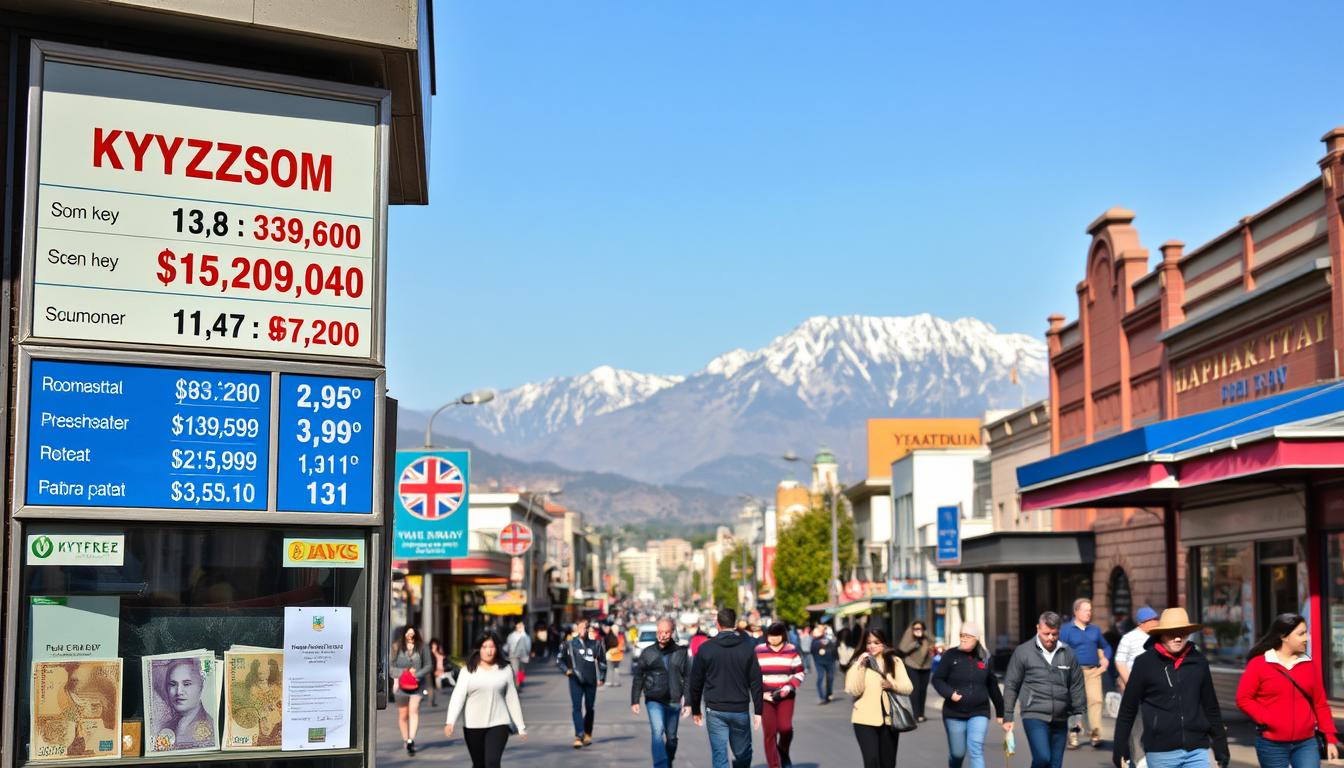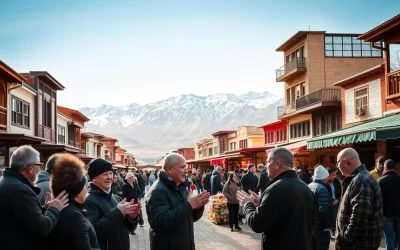✓ Accommodations✓ Flights✓ Rental Cars✓ Tours & Activities
Did you know that the official currency of this stunning Central Asian destination, the Kyrgyzstani Som, comes in denominations like 20, 50, 100, and even 5,000 som? Managing your money here doesn’t have to be complicated, but it does require some planning.
Whether you’re exploring bustling markets or serene mountain trails, understanding the local exchange rate and payment options can make your trip smoother. From using cash at local shops to finding reliable ATMs, this guide will help you navigate it all.
You’ll also learn how to avoid unnecessary fees and choose the best card options for your journey. With a mix of traditional and modern payment methods, you’ll be ready to enjoy every moment without worrying about your budget.
Overview of Kyrgyzstan’s Currency and Payment Landscape
From cash to cards, this country offers a mix of traditional and modern payment methods. While cash remains the go-to option in many places, card payments are becoming more common, especially in urban areas. Knowing how to balance these options can make your travel experience smoother.
Before you arrive, it’s essential to understand the local exchange rate. This will help you budget better and avoid unnecessary costs. Keep in mind that while ATMs are widely available in cities, remote areas often require cash. Planning ahead ensures you’re never caught off guard.
In larger cities like Bishkek and Osh, both local and international cards are accepted. Visa and MasterCard are particularly useful for dining, shopping, and accommodations. However, always carry some cash for smaller vendors or rural spots.
To manage your money effectively, create a daily plan. This helps you avoid extra fees or unfavorable rates. Whether you’re exploring bustling markets or serene landscapes, being prepared lets you focus on the adventure.
For more detailed tips and personal insights, continue reading the upcoming sections. They’ll help you navigate every aspect of your travel finances with ease.
Understanding the Kyrgyzstani Som – Banknotes and Coins
Navigating the local currency system starts with knowing the som and its various denominations. The Kyrgyzstani som is divided into banknotes and coins, each serving different purposes in daily transactions. Banknotes come in values of 20, 50, 100, 200, 500, 1,000, and 5,000 som, while coins are available in 1, 3, 5, and 10 som. Understanding these values helps you budget effectively and avoid confusion.
When exchanging money, it’s essential to verify the current exchange rate. Apps like Xe.com can provide real-time updates, ensuring you get the best deal. Always check the condition of your bills before exchanging them. Damaged or worn-out notes may fetch lower rates, so aim for crisp, clean currency.
Denominations and Exchange Details
Here’s a breakdown of the som’s banknotes and coins:
| Type | Denomination |
|---|---|
| Banknotes | 20, 50, 100, 200, 500, 1,000, 5,000 som |
| Coins | 1, 3, 5, 10 som |
Smaller denominations are handy for daily expenses like transportation or snacks. Keep a mix of banknotes and coins to ensure you’re prepared for any situation.
Tips for Locating Exchange Offices
Finding trusted exchange offices is crucial for securing favorable rates. In Bishkek, Manas Avenue is a popular spot for reliable kiosks. In Osh, the Kelechek market offers competitive rates. Always compare rates at multiple locations before making a transaction.
“Exchange offices in busy areas often provide better rates than those at airports or hotels.”
Carry small denominations as backup funds, especially when visiting rural areas where ATMs are scarce. By planning ahead, you can ensure a smooth and stress-free travel experience.
ATMs, Card Payments, and Cash: What You Need to Know
Managing your finances while exploring new destinations is easier when you know the ins and outs of local payment systems. In many places, cash remains the primary option, but cards are gaining traction, especially in urban areas. Balancing these methods ensures you’re prepared for any situation.
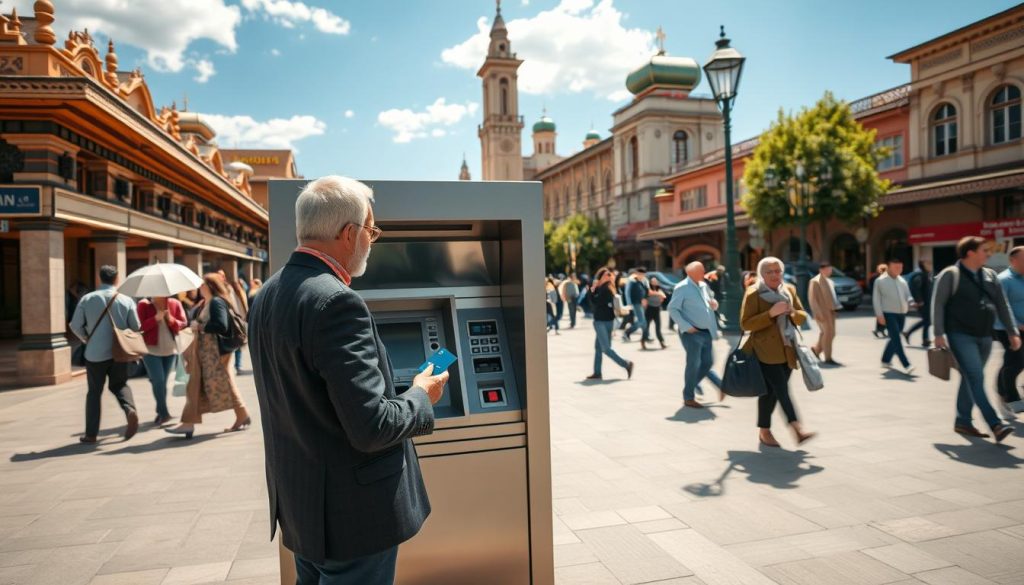
ATM Withdrawal Guidelines
Finding and using ATMs effectively is key to managing your money. Most machines in cities accept Visa cards, but rural areas may have limited access. Demir Bank is a reliable choice for MasterCard users. Withdrawal limits are typically around 20,000 KGS (approx. $200) per transaction.
To avoid extra fees, use bank-affiliated ATMs. Check with your home bank about international withdrawal charges. Apps like Xe.com can help you monitor the rate and plan your withdrawals efficiently.
Visa, MasterCard, and Other Card Usage
Cards are widely accepted in larger cities for dining, shopping, and accommodations. Visa is the most common, but MasterCard works at select locations like Demir Bank. Always carry a backup credit card in case of issues.
In rural areas, cash is often the only option. Plan multiple withdrawal stops to avoid running out of funds. Digital tools and mobile banking apps can help you track your balance and exchange rates on the go.
| Bank | Card Accepted | Withdrawal Limit | Typical Fee |
|---|---|---|---|
| Demir Bank | MasterCard | 20,000 KGS | 1-2% |
| Other Banks | Visa | 20,000 KGS | 1-3% |
By following these guidelines, you can navigate payments smoothly and focus on enjoying your travel experience. Always prioritize safety by using secure machines and keeping your money organized.
Essential Travel Money Cards for Convenient Payments
Choosing the right travel money card can make your journey smoother and more cost-effective. With options like Wise, Chime, Monzo, and Netspend, you can manage your money efficiently while avoiding unnecessary fees. Each card offers unique features tailored to different spending habits and travel needs.
Comparing Wise, Chime, Monzo, and Netspend
The Wise Multi-Currency Card is a popular choice for its low fees and mid-market exchange rates. It allows you to hold and convert multiple currencies, making it ideal for frequent travelers. However, it’s worth noting that some ATM withdrawals may incur small charges.
Chime stands out for its no foreign transaction fees, making it a budget-friendly option. It also supports mobile wallets like Apple Pay, ensuring secure and convenient payments. However, Chime’s international ATM withdrawal fees can add up if you’re not careful.
Monzo is another excellent choice, offering no ATM fees and real-time spending notifications through its app. It’s perfect for those who want to track their expenses on the go. However, Monzo’s currency conversion rates may not always be the most competitive.
Netspend provides a prepaid card option with flexible reloading options. While it’s convenient for controlling your spending, be aware of its higher fees for certain transactions and ATM withdrawals.
“The right travel money card can save you time and money, letting you focus on enjoying your trip.”
When selecting a card, consider your spending habits and travel plan. Whether you prioritize low fees, ease of use, or security, there’s a card that fits your needs. Don’t forget to check if your chosen card supports contactless payments and mobile wallets for added convenience.
By choosing wisely, you can ensure a hassle-free travel experience, keeping your money safe and accessible wherever you go.
Advanced Guide to Exchange Rates and Currency Conversion
Tracking exchange rates can save you money and simplify your travel budget. Understanding how they work ensures you get the best value for your money. The mid-market rate, often considered the fairest, is the midpoint between the buy and sell prices of two currencies. It’s the rate banks use when trading among themselves.
Tools like the Xe.com app provide real-time updates, helping you monitor currency values effortlessly. This app is especially useful for travelers who need to stay informed about fluctuations. By using it, you can plan your conversions in advance and avoid unnecessary costs.
Timing is crucial when converting currency. Exchange rates fluctuate throughout the day due to economic factors. Converting during periods of stability or favorable trends can save you money. For example, if the rate is expected to rise, waiting a bit longer might yield better results.
Here’s a quick comparison of online converters and bank rates:
| Tool | Pros | Cons |
|---|---|---|
| Xe.com | Real-time updates, user-friendly | Small fees for premium features |
| Bank Rates | Reliable, secure | Often less competitive |
To budget effectively, use current exchange data to estimate daily expenses. Apps like Xe.com allow you to set up alerts, notifying you when the rate reaches your desired level. This feature helps you lock in favorable rates and avoid costly conversions.
“Setting up alerts on currency apps ensures you never miss a good exchange rate.”
By mastering these tips, you can navigate exchange rates confidently and make the most of your travel budget. Whether you’re converting currency or monitoring trends, staying informed is the key to financial efficiency.
Budgeting Your Trip and Managing Daily Expenses
Planning your daily budget is key to enjoying your trip without financial stress. Whether you’re dining out, shopping for groceries, or exploring local markets, understanding typical costs helps you stay on track. Here’s how to manage your money effectively during your travel.
Cost of Meals, Groceries, and Dining Out
Eating out can be a highlight of your day, but it’s important to balance it with grocery shopping to save money. A basic meal at a local restaurant costs around $8, while groceries for a day might be half that. Supermarkets are an economical choice, offering fresh produce and snacks at lower prices.
Here’s a quick breakdown of sample costs:
| Expense | Average Cost |
|---|---|
| Basic Meal | $8 |
| Groceries (per day) | $4 |
| Mid-Range Restaurant | $15 |
To avoid hidden fees, always check menus for additional charges like service fees or taxes. Using budgeting apps like Mint or YNAB can help you track your spending and stick to your plan.
“Local supermarkets are a budget-friendly way to enjoy fresh meals without overspending.”
When converting currency, use reliable tools like Xe.com to monitor exchange rates. This ensures you get the best value for your money. By planning ahead and keeping a mix of cash and cards, you’ll always be prepared for your daily needs.
Accommodation Options and Payment Considerations
Finding the perfect place to stay can make or break your travel experience. From budget-friendly guesthouses to unique yurt stays, there’s an option for every traveler. Understanding the pros and cons of each choice helps you plan better and avoid unnecessary costs.
Guesthouses and homestays are popular for their affordability and local charm. They often accept cash, so it’s wise to carry enough money. Hotels, especially in cities, usually take cards, but always confirm payment methods in advance. Platforms like Booking.com are great for securing deals and comparing prices.
For a truly unique experience, consider staying in a yurt. These traditional dwellings offer a glimpse into local culture and are often located in scenic areas. Prices range from $20 to $50 per night, depending on the location and amenities. Booking in advance is recommended, especially during peak seasons.
In rural areas, arriving on the spot can sometimes lead to better deals, but it’s risky during busy periods. Pre-booking ensures you have a place to stay, even in remote locations. Always check for hidden fees at check-in, such as service charges or taxes, to avoid surprises.
“Staying in a yurt is not just about accommodation—it’s an unforgettable cultural experience.”
By balancing your plan with flexibility, you can enjoy comfortable stays without overspending. Whether you choose a cozy guesthouse or a traditional yurt, being prepared ensures a smooth and enjoyable trip.
Navigating Local Transportation and Payment Methods
Exploring a new country is exciting, but understanding its transportation system is key to a smooth journey. From buses to taxis, each option offers unique advantages for travelers. Knowing how to navigate these systems saves time and money, ensuring a stress-free travel experience.
Marshrutkas, Shared Taxis, and City Buses
Marshrutkas, or minibuses, are a popular and affordable way to get around. Within cities, fares start at 15 KGS, while intercity rides can cost around 500 KGS. These vehicles follow fixed routes, making them a reliable option for daily commutes.
Shared taxis are another common choice, especially for longer distances. Negotiating fares in advance is essential to avoid overpaying. For city buses, tickets typically cost 10 KGS, offering a budget-friendly way to explore urban areas.
Using Ride-Sharing Apps
In cities like Bishkek, apps like Yandex Go make hailing a taxi easy and safe. These platforms provide upfront pricing, reducing the risk of scams. Always confirm the fare before starting your ride to avoid surprises.
Tips for Safe and Affordable Travel
When negotiating long-distance rides, agree on the cost beforehand. Be cautious of drivers who quote inflated prices. Carrying small denominations of local currency ensures you’re prepared for any situation.
Understanding route numbers and schedules helps you navigate public transport efficiently. Apps like Google Maps can provide real-time updates, making your day more organized.
“Planning your transport in advance saves time and ensures a smooth journey.”
Transport Cost Overview
| Transport Type | Average Cost |
|---|---|
| Marshrutka (City) | 15 KGS |
| Marshrutka (Intercity) | 500 KGS |
| City Bus | 10 KGS |
| Shared Taxi | Varies (Negotiable) |
By mastering these tips, you can navigate local transport confidently and focus on enjoying your travel adventure. Whether you’re hopping on a marshrutka or hailing a taxi, being prepared ensures a seamless experience.
How to Safely Exchange Money in Kyrgyzstan
Exchanging money safely is a key part of any trip, especially in unfamiliar places. Whether you’re at a bank or a local exchange office, following a few simple steps can protect your money and ensure you get the best rate.
Start by choosing reputable exchange offices. Avoid stands at airports, as they often charge higher fees. Instead, look for trusted locations in city centers or near major landmarks. Always verify the current exchange rate before making a transaction to avoid unfavorable deals.
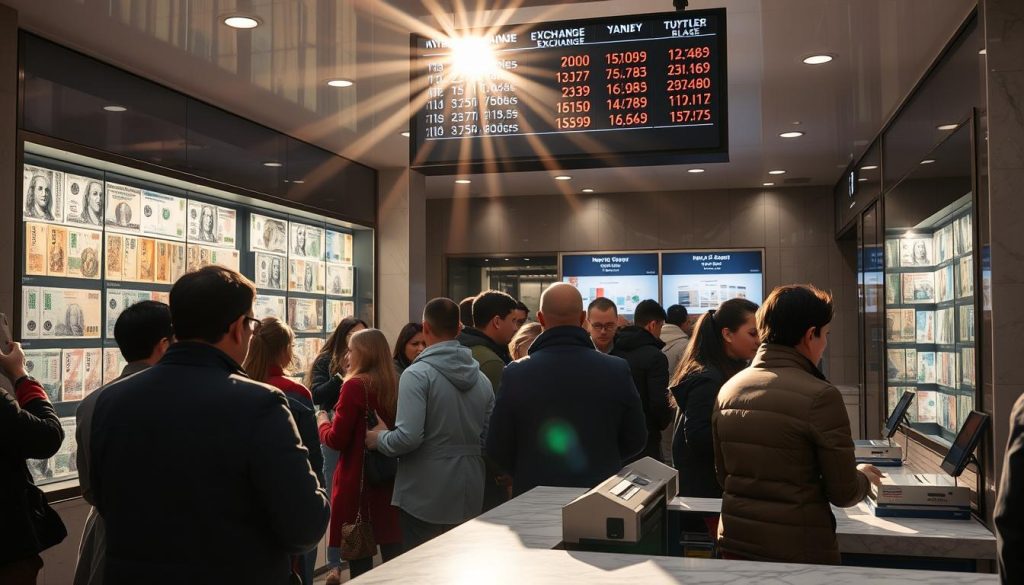
When exchanging, inspect the condition of your bills. Worn or damaged currency may fetch lower rates. Use small denominations for daily expenses and keep larger bills for emergencies. This approach ensures you’re prepared for any situation during your travel.
“Always ask for a receipt when exchanging money. It’s your proof of transaction and helps resolve any disputes.”
Here’s a checklist to keep your exchanges safe and efficient:
- Choose reputable exchange offices or banks.
- Verify the rate and condition of your currency.
- Avoid airport stands due to higher fees.
- Ask for a receipt after every transaction.
- Plan your exchanges in advance to avoid last-minute stress.
By following these tips, you can ensure a smooth and secure currency exchange experience. Staying informed and prepared lets you focus on enjoying your travel without worrying about your funds.
| Location | Pros | Cons |
|---|---|---|
| City Exchange Offices | Better rates, reputable | May have limited hours |
| Airport Stands | Convenient | Higher fees |
| Banks | Secure, reliable | Longer wait times |
Insider Tips for Avoiding Extra Fees and Scams
Navigating financial transactions in a new destination can be tricky, but with the right tips, you can avoid extra fees and scams. Whether you’re exchanging money or hailing a taxi, knowing how to spot red flags and negotiate effectively can save you both time and money.
Negotiating Rates and Recognizing Dodgy Deals
When exchanging currency, always verify the current rate and compare offers from multiple vendors. Use crisp, large bills for better deals, as worn-out currency may fetch lower rates. Ask local hosts or trusted sources for reliable exchange offices to avoid scams.
For taxis, confirm the fare before starting your ride. Apps like Yandex Go provide upfront pricing, reducing the risk of overcharging. If you’re negotiating directly, use basic local phrases to communicate effectively and secure a fair deal.
Common Scams to Watch Out For
Be cautious of common scams like note-switching during money exchanges or inflated taxi fares. In markets, fake souvenirs and ticket scams are prevalent. Always double-check your change and avoid unofficial sellers.
“Confirming prices beforehand and comparing rates between vendors can save you from unnecessary expenses.”
Safe Practices for Financial Transactions
Use digital payment methods or trusted travel cards to avoid hidden fees. Platforms like Wise or Monzo offer low fees and real-time spending notifications, making them ideal for managing your money abroad.
Here’s a quick comparison of safe payment options:
| Option | Pros | Cons |
|---|---|---|
| Wise | Low fees, multi-currency support | Small ATM withdrawal fees |
| Monzo | No ATM fees, real-time notifications | Less competitive conversion rates |
By following these insider tips, you can navigate financial transactions confidently and focus on enjoying your travel experience. Proactive planning and awareness are key to avoiding scams and extra fees.
Kyrgyzstan: Ultimate Travelers Guide to Currencies & Payments
Understanding the local currency and payment methods can significantly enhance your travel experience. This guide has covered everything from exchanging cash to using digital payments, ensuring you’re well-prepared for your journey.
Before arriving, it’s essential to familiarize yourself with the local exchange rate and payment practices. This knowledge helps you avoid unnecessary fees and ensures smooth transactions. Whether you’re using ATMs or carrying cash, planning ahead is key.
Using the right card can save you time and money. Options like Wise and Monzo offer low fees and real-time spending notifications, making them ideal for managing your travel budget. Always carry a backup card in case of emergencies.
Here’s a quick recap of the major points covered in this guide:
| Topic | Key Tips |
|---|---|
| Currency Exchange | Verify rates, use trusted offices, and inspect bills. |
| Card Usage | Choose low-fee cards, carry backups, and monitor spending. |
| Cash Management | Carry small denominations, plan withdrawals, and avoid airport exchanges. |
Always prioritize safety when handling financial transactions. Use secure ATMs, confirm prices before paying, and avoid unofficial vendors. These practices protect your money and ensure a stress-free trip.
“Preparation and awareness are your best tools for navigating financial transactions abroad.”
As you prepare for your journey, review the detailed comparisons and insider tips provided in this guide. They’ll help you make informed decisions and enjoy every moment of your travel adventure.
Benefits of Travel Insurance and Secure Payment Practices
Travel insurance is a must-have for any trip, offering peace of mind and financial protection. It covers unexpected events like medical emergencies, trip cancellations, or lost luggage. Without it, you could face significant costs that disrupt your travel plans.
Secure payment practices are equally important. Using non-linked travel money cards protects your regular bank account from fraud. These cards are designed for international use, often with low fees and enhanced security features.
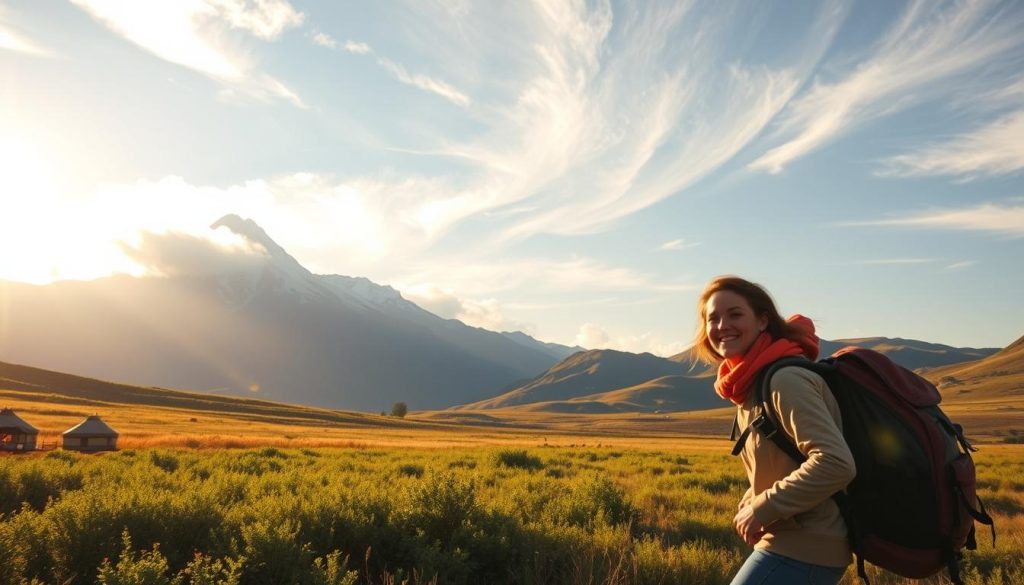
- Use cards with fraud protection and instant freezing through a mobile app.
- Avoid using public Wi-Fi for financial transactions.
- Carry a mix of cash and cards for flexibility.
Emergency cash services are another valuable option. Some insurance providers offer this feature, ensuring you’re never stranded without funds. Additionally, instant card freezing through apps like Wise or Monzo adds an extra layer of security.
“The affordable premium of travel insurance is a small price to pay compared to potential losses from unexpected events.”
When choosing a credit card, verify it offers travel benefits like rental car insurance or trip delay coverage. These perks can save you money and enhance your travel experience. Always read the fine print to understand what’s included.
By combining travel insurance with secure payment practices, you can enjoy your trip worry-free. It’s a smart plan that ensures you’re prepared for any situation. For more tips, consult this guide to make informed decisions about your finances abroad.
Managing Digital Payments and Mobile Wallets Abroad
Digital payments and mobile wallets are transforming the way you manage money while traveling. These tools simplify transactions, making it easier to pay for meals, transportation, and souvenirs without carrying cash. With just a few taps on your phone, you can complete purchases securely and efficiently.
Mobile wallets like Apple Pay and Google Pay are becoming increasingly popular. They allow you to link your travel card and make contactless payments wherever supported. This option is not only convenient but also reduces the need to carry physical cards or cash.
Using a travel card with a mobile app offers additional benefits. You can track your spending in real-time, set budgets, and receive notifications for every transaction. This helps you stay on top of your travel expenses and avoid overspending.
Digital payments often come with minimal fees and favorable exchange rates. Unlike traditional methods, they eliminate hidden charges and provide transparent pricing. This makes them a cost-effective way to manage your finances abroad.
“Mobile wallets and digital payments offer a seamless and secure way to handle transactions while traveling.”
Security is a top priority with these tools. Most payment apps offer two-factor authentication, ensuring your money is protected. Additionally, you can instantly freeze your card through the app if it’s lost or stolen.
To get started, download your travel card provider’s app and link your account. Set up notifications and explore features like spending analytics. Integrating these tools into your plan ensures a stress-free and organized trip.
By embracing digital payments and mobile wallets, you can enjoy a smoother and more secure travel experience. These modern solutions are designed to make managing your finances easier, so you can focus on exploring and creating memories.
Practical Advice for Remote Locations and Rural Areas
Exploring remote areas requires a different approach to managing your finances. Unlike cities, rural regions often lack card facilities, making cash your primary option. Carrying extra money ensures you’re prepared for any situation during your trip.
Transportation in rural areas can be unpredictable. Shared taxis or private drivers are common, but costs may vary. Always confirm fares in advance to avoid overpaying. Offline maps and apps like Maps.me can help you locate nearby vendors and accommodations.
Here are some practical tips for staying financially flexible in remote regions:
- Carry extra cash for daily expenses and emergencies.
- Check for ATM availability before venturing into rural areas.
- Use offline maps to navigate and find essential services.
- Plan your day to avoid unexpected costs.
“Preparation is key when traveling to remote areas. Always have a backup plan for your finances.”
By following these tips, you can ensure a smooth and secure travel experience, even in the most remote parts of the country. Staying informed and prepared lets you focus on enjoying your adventure without worrying about your funds.
Real Traveler Experiences and Hidden Payment Pitfalls
Learning from others’ experiences can save you from common financial pitfalls while traveling. Many visitors have shared their stories of unexpected fees, scams, and lessons learned. These insights can help you avoid similar issues and make your trip smoother.
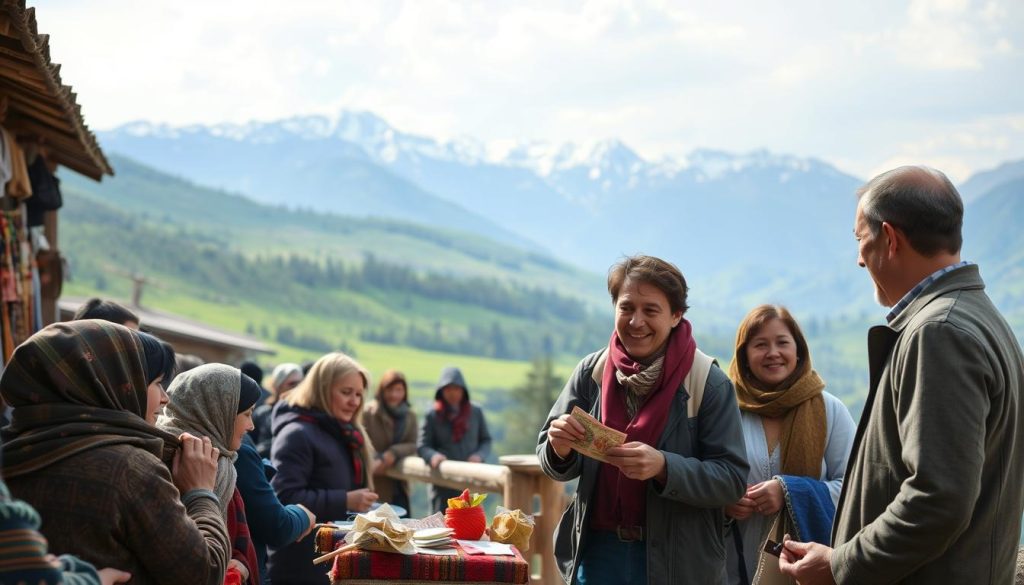
Personal Stories and Lessons Learned
One traveler shared how they were overcharged by a taxi driver who didn’t use the meter. “Always confirm the fare before starting your ride,” they advised. Another visitor encountered a dodgy exchange office that offered rates far below the market value. They emphasized the importance of verifying rates at multiple locations.
Proper research and planning can prevent many issues. For example, a couple avoided ATM fees by using a bank-affiliated machine. They also carried a mix of cash and cards, which proved useful in rural areas where card payments weren’t accepted.
“Reading local reviews and asking for advice from past travelers made a huge difference in our trip.”
Here are some key lessons from real-life experiences:
- Always carry small denominations for daily expenses.
- Use trusted exchange offices and verify rates before exchanging money.
- Confirm taxi fares in advance or use ride-sharing apps for upfront pricing.
- Carry a backup card in case of emergencies.
By following these tips, you can navigate financial transactions confidently. Real stories from fellow travelers provide valuable insights and help you stay prepared. Whether it’s avoiding scams or managing your money wisely, these lessons ensure a stress-free travel experience.
Conclusion
Managing your finances abroad doesn’t have to be stressful with the right preparation. This guide has provided essential tips to help you navigate currency exchange, use travel cards, and handle cash safely. By planning ahead, you can avoid unnecessary costs and focus on enjoying your journey.
Always verify exchange rates and choose reputable banks or offices for transactions. Carry a mix of cash and cards to ensure flexibility, especially in remote areas. Using secure payment methods like mobile wallets or travel cards adds an extra layer of safety.
Take a proactive approach to researching fees and rates. This simple step can save you money and make your trip smoother. Apply the insights from this guide to manage your money wisely and enjoy a hassle-free experience.
With proper planning, handling finances while traveling becomes effortless. Stay informed, stay prepared, and make the most of your adventure!
The above is subject to change.
Check back often to TRAVEL.COM for the latest travel tips and deals.
